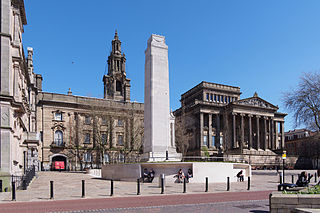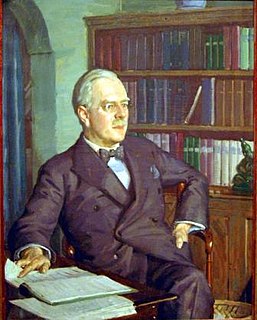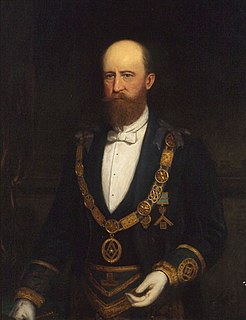John Ignatius Bleasdale (1822–1884) was an English-born Roman Catholic priest, chemist and mineralogist active in Australia and president of the Royal Society of Victoria in 1865.

England is a country that is part of the United Kingdom. It shares land borders with Wales to the west and Scotland to the north-northwest. The Irish Sea lies west of England and the Celtic Sea lies to the southwest. England is separated from continental Europe by the North Sea to the east and the English Channel to the south. The country covers five-eighths of the island of Great Britain, which lies in the North Atlantic, and includes over 100 smaller islands, such as the Isles of Scilly and the Isle of Wight.

A priest or priestess is a religious leader authorized to perform the sacred rituals of a religion, especially as a mediatory agent between humans and one or more deities. They also have the authority or power to administer religious rites; in particular, rites of sacrifice to, and propitiation of, a deity or deities. Their office or position is the priesthood, a term which also may apply to such persons collectively.

Mineralogy is a subject of geology specializing in the scientific study of the chemistry, crystal structure, and physical properties of minerals and mineralized artifacts. Specific studies within mineralogy include the processes of mineral origin and formation, classification of minerals, their geographical distribution, as well as their utilization.
Bleasdale was born in Kirkham in Lancashire. He was educated at private schools in Preston, then trained to become a priest (1835 to 1845), first at the English College, Lisbon, in Portugal then, forced to return to England by ill health, at St Mary’s College, Oscott in [1] Birmingham. Following his ordination by Cardinal Wiseman, Bleasdale served as a military chaplain in Weedon [1] in Britain. He arrived in Victoria (Australia) in 1851 and was appointed to the mission in Geelong. In 1855 he became vice-president of St Patrick's College in Melbourne. He was for several years private secretary to the Bishop of Melbourne. [1]

Kirkham is a small town and civil parish in the Borough of Fylde in Lancashire, England, midway between Blackpool and Preston and adjacent to the smaller town of Wesham. It owes its existence to Carr Hill upon which it was built and which was the location of a Roman fort. At the Census of 2011 it had a population 7,194.

Lancashire is a ceremonial county in North West England. The administrative centre is Preston. The county has a population of 1,449,300 and an area of 1,189 square miles (3,080 km2). People from Lancashire are known as Lancastrians.

Preston is a city and the administrative centre of Lancashire, England, on the north bank of the River Ribble.
Bleasdale was a foundation member of the Melbourne Microscopical Society, a fellow of the Geographical and Linnean societies and honorary member of Medical Society of Victoria. He was also one of the leading advocates for wine in Victoria.
Bleasdale migrated to California in 1877 and died in San Francisco in June 1884.

California is a state in the Pacific Region of the United States. With 39.6 million residents, California is the most populous U.S. state and the third-largest by area. The state capital is Sacramento. The Greater Los Angeles Area and the San Francisco Bay Area are the nation's second and fifth most populous urban regions, with 18.7 million and 9.7 million residents respectively. Los Angeles is California's most populous city, and the country's second most populous, after New York City. California also has the nation's most populous county, Los Angeles County, and its largest county by area, San Bernardino County. The City and County of San Francisco is both the country's second-most densely populated major city after New York City and the fifth-most densely populated county, behind only four of the five New York City boroughs.
Frank Potts (1815–1890) named his Bleasdale Winery in Langhorne Creek, South Australia, for him though there is no evidence the two ever met. [2]
Frank Potts was the founder of Bleasdale winery at Langhorne Creek, South Australia, which has remained in the Potts family to the present day.

Langhorne Creek is a town in South Australia. At the 2011 census, Langhorne Creek had a population of 668.











